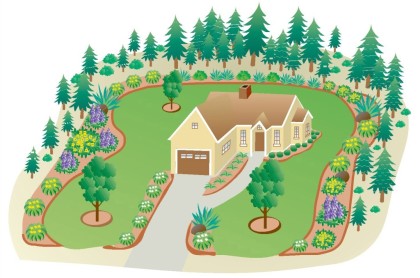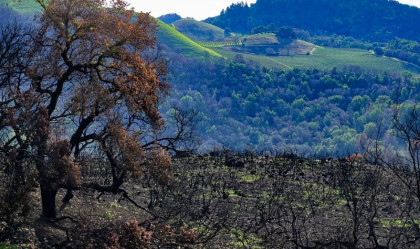Wildfires: Protecting our homes – and our forests
— The Sonoma County Climate Activist Network
Fire has been part of the California landscape for eons. We will not stop fire; we need to protect homes and communities from fire, keep evacuation routes clear, and stop new building in fire-prone zones. Sonoma County Supervisors recently approved $3.7 million for vegetation management projects to reduce wildfire risk.
Jack Cohen, PhD, a Research Physical Scientist retired from the US Forest Service, showed conclusively and repeatedly with thousands of studies that the best way to protect homes from fire is by home hardening, and creating defensible space up to 100 feet around homes. Most of the wildfires that destroy homes are ignited by wind-driven embers landing on flammable materials close to homes, or blowing in through open vents.
 Home hardening can be as simple as clearing flammable objects from immediately around homes and covering vents with 1/16 inch wire mesh, to installing fire resistant roofs and sprinkler systems. Creating defensible space up to 100 feet from homes by removing dead vegetation and ladder fuels is also important.
Home hardening can be as simple as clearing flammable objects from immediately around homes and covering vents with 1/16 inch wire mesh, to installing fire resistant roofs and sprinkler systems. Creating defensible space up to 100 feet from homes by removing dead vegetation and ladder fuels is also important.
There is little evidence that clearing vegetation in forests far from homes helps to protect homes and communities from fire; in fact it can make matters much worse by removing the vegetation that shades the forests, keeping them cool and moist, instead allowing exposed soil to dry out and wind-driven fires to race through, and making way for invasive weeds and grasses that are more flammable than the plants they replace. Logging did not save the town of Paradise from the Camp fire.
Aerial photos show homes razed to the ground surrounded by trees barely touched by fire. “Vegetation management” and “fuel load reduction” sound so benign, but in reality these are code words for logging. Post-fire salvage logging destroys valuable habitat and removes some of the most fire-resistant trees. Thousands of acres in Sonoma County are being cut now, yet few know how widespread these removals are, as much of the cutting is unregulated or does not require permits.
Climate scientist Dr. Bill Moomaw argues that the best way to counter climate change is to sequester carbon in existing forests. Protecting forests is also one of the best ways to protect wildlife habitat and our watersheds. The heavy equipment used in vegetation removal compacts the soil, leading to erosion, which in turn runs off as sediment, clogging streams, rivers, and wetlands.
Yet under the name of “vegetation management” or “fuel load reduction,” financial incentives lead to the cutting of the largest trees – and the price of lumber is at an all-time high.
The Supervisors recently held a Tree Ordinance workshop, recognizing the valuable role trees play in providing precious wildlife habitat, protecting our watersheds, and sequestering carbon. Yet thousands of acres of trees are being logged in the name of public safety and protection from fire, even forest health.
George Wuerthner, a retired forester, explains that there are two distinct ways of seeing forests. Foresters in general see trees as so many feet of board lumber – a resource to be extracted for our use. Fire ecologists see trees as more valuable in their natural state than when managed, and to them fire, dead wood, fungi, beetles, and all the things that foresters want to suppress, are essential parts of the ongoing natural processes that make up the interconnected living, breathing, systems we call forests.

At the state level, Governor Newson approved a fire budget of $1.24 billion for wildfire and forest resilience funding, with $25 million, just 2% of the total, for home hardening. Why isn’t more being spent to help homeowners, apartment complexes, mobile home parks, with proven methods of home hardening and creating defensible space? “In addition to being more effective, home-safety actions can produce more jobs and better-paying jobs than an equivalent amount of money spent subsidizing logging and other forest-altering activities” (Niemi, 2018). $39 million is allocated for “science-based management” but more than twice as much, $76 million, for “forest sector economic stimulus.” Basically this monetizes the forests and incentivizes forest-based business.
Surely the first rule of operation should be to do no harm. Forests regulate temperature, store carbon above and below ground, create oxygen, create soil, purify our air and water, provide essential wildlife habitat, and so much more. We depend upon forests and destroy them at our peril. Let’s focus our resources on protecting human lives and property from fire by incentivizing home hardening and the creation of defensible space and protect existing forests and ensure that we do no harm. “Working From the Home Outward: A New Direction for California Wildfire Policy” is an excellent resource explaining why and how we can protect both our homes and our forests.
To sacrifice our forests to save our homes is a false solution which will only lead to disaster.
The Sonoma County Climate Activist Network (SoCoCAN!) a network of over 50 local climate activist groups, over 200 individuals, and hundreds of local group members working together to address and reverse climate change. It meets in months with a fifth Monday, 7-9 p.m.
One thought on “Wildfires: Protecting our homes – and our forests”
Comments are closed.







These tree hugging people are cuckoo and somewhat responsible for the forests burning! Let people feel safe and remove the dead trees!